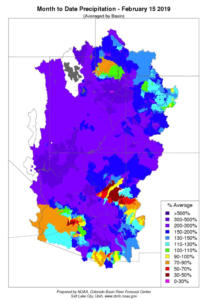
This map from the Colorado Basin River Forecast Center shows higher snow levels in the Colorado Basin as of Feb. 15, 2019. The purple represents areas with 300 to 500 percent of average snowfall levels.
This past week, gazing at the mountains to the west of Imperial County, the snowcapped peaks—gleaming white against a new day’s sun—were awe inspiring. But beyond the beauty of the winter snowfall is the importance of this season’s weather pattern to the struggling Colorado River Basin.
As we are still in the midst of drought, Lake Mead is tilting ever closer to a shortage declaration that would impact all states that depend on the mighty Colorado River.
While snowfall levels within the Basin are above average, it remains too early to determine what the actual benefit will be. However, it would not be beyond reason to believe that an earlier projection by the Bureau of Reclamation—one that stated the likelihood of a shortage declaration in 2020 stood at 69 percent—could change for the better. But even if it did, the drought impacting the Basin would continue. We would need to have several good consecutive snow years in order to address the long-term drought.
Then comes the question of how the weather fits into the ongoing efforts to finalize a drought contingency plan which, if approved, would govern river operations through 2026. The Drought Contingency Plan (DCP), a measure introduced by the Bureau of Reclamation, seeks more conservation among all the Basin states to prevent Lake Mead from falling to critically low elevation levels. Anyone who has followed the DCP knows there are a number of issues that must be addressed in order to finalize the plan. This blog is not meant to address those specific issues, short of stating they all point to the complicated nature of water management when there is so much at stake.
In regard to the recent weather’s impact on DCP efforts, it is safe to say that the concern over drought and a shortage declaration will remain largely unaffected regardless of this year’s weather and resulting hydrology. The Bureau of Reclamation has been pushing for the finalization of the DCP by March 4, or face alternative actions. The various states and agencies continue to diligently work through remaining issues to reach a DCP that serves everyone’s best interests. If the DCP isn’t complete by the March deadline, there will be a 15-day comment period for all the Basin States’ governors to provide input for alternative actions by the federal government.
Again, there is a great deal at stake and even Mother Nature’s recent snow flurry can’t help much—not in the long-term—not without sustained wet and snowy years.
All of that said, if this recent weather even helps a little, then that is something to celebrate. At this point, all we can do is stay tuned to weather updates and for the Bureau’s next report in April when there will be an update on the likelihood of shortage for the next five years. No matter what those projections indicate, there will still be a need for all of us to do what we can to manage our own individual water use. When in a sustained drought like the Colorado River is experiencing, every drop still counts.
Stay tuned to this blog for updates on the drought, DCP, the Quantification Settlement Agreement, the Salton Sea and all matters related to water supplies.
